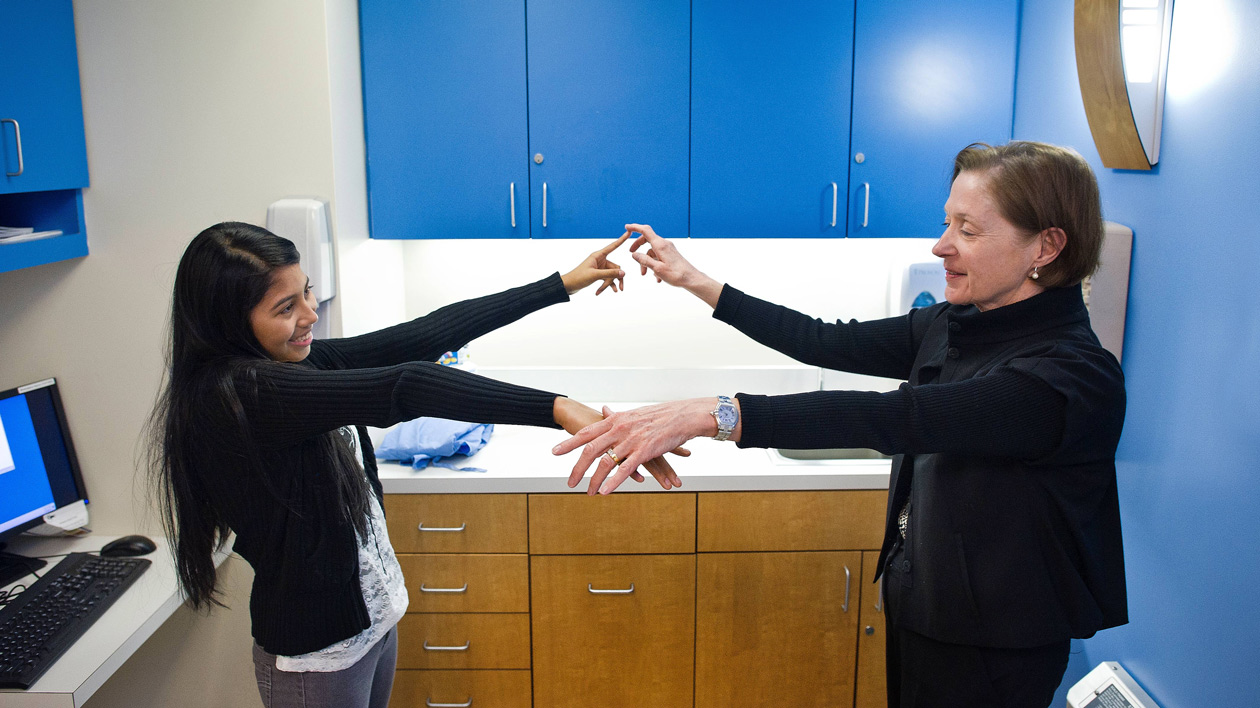Main content
We use cookies and similar tools to give you the best website experience. By using our site, you accept our Websites Privacy Policy.
Doctors at Hassenfeld Children’s Hospital at NYU Langone are experienced in diagnosing scoliosis, a condition that causes the spine to curve like an S or a C. Our specialists can assess the extent of your child’s spinal curvature, determine if the vertebrae—the small bones that make up the spine—are compressing the spinal cord or pushing against the ribs, and identify the best strategy to prevent it from getting worse.
Scoliosis occurs in up to 3 percent of children and adolescents and is most common in teenage girls. Most children have idiopathic scoliosis, which means the condition develops for unknown reasons.

The condition can also be inherited and can occur in children with genetic, neurological, neuromuscular, or musculoskeletal conditions that affect spine development, such as achondroplasia, cerebral palsy, muscular dystrophy, neurofibromatosis, and spina bifida. Scoliosis can also occur in children with Chiari malformation, a structural abnormality in the spinal cord that causes balance problems.
Certain tumors in the spinal column, spinal cord, or areas surrounding the spinal cord—which may be benign or on a rare occasion may be cancerous—can also cause scoliosis. Our doctors are experienced in caring for children with idiopathic scoliosis as well as for those who have spinal curvature caused by other conditions.
Our orthopedic specialists perform a comprehensive physical exam and use the results of sophisticated imaging tests to make an accurate assessment and determine whether your child’s spinal curve is likely to get worse. This information can also help our doctors to predict peak growth periods for your child and to identify the best opportunity to intervene.
During a physical exam, the doctor may ask your child to repeat the Adam’s forward bend test. If your child’s back is noticeably uneven, additional tests may be performed to obtain a detailed image of the spine and measure the angle of the curve.
Our experts may also ask your child whether he or she is experiencing severe pain, numbness, or tingling, which can occur when misaligned vertebrae press on nerves in the back. Severe pain can also be due to benign spinal tumors or cysts—other conditions that can cause spinal curvature.
In children with mild or moderate curvature, our experts occasionally use the ScoliScore™ AIS Prognostic Test to determine whether your child’s scoliosis is likely to worsen. This test identifies certain genes in saliva that are associated with scoliosis progression.
Most children with spinal curvature have some type of imaging test, which provides a detailed picture of the spine and allows doctors to measure the angle or extent of the curve. Imaging tests are also used to look for other spinal problems, which, in rare instances can lead to neurological symptoms such as numbness, tingling, pain, and muscle weakness.
Imaging tests can also be used to identify unusual causes of scoliosis or severe back pain, such as congenital deformities and cysts.
Spine X-rays capture snapshots of the bony parts of the spine, such as the vertebrae, and allow doctors to measure the degree of curvature.
Your child's doctor may choose to use a standard X-ray or EOS® imaging, a type of X-ray in which the least amount of radiation possible is used to obtain a three-dimensional picture of your child’s spine while he or she is standing. Doctors often prefer to use imaging that has the least amount of radiation to monitor the progression of a spinal curvature and to evaluate changes in the spine during and after treatment for scoliosis.
Bone age studies—X-rays of the wrists, hands, and top of the pelvis—are used to examine the growth plates, the islands of cartilage located at the ends of long bones that gradually close as a child becomes fully grown. Because scoliosis progresses during peak growth periods, the results of bone age studies can help your child’s doctor to predict whether scoliosis is likely to worsen and what treatments may be most effective.
MRI scans produce detailed images of areas that are more difficult to see on an X-ray, such as the spinal cord, cartilage, and ligaments. This test can also help doctors to detect other conditions that can cause scoliosis, such as a cyst or tumor on the spinal cord, or a tethered cord, in which the spinal cord is attached to the bony part of the spine.
Our doctors use information from these tests to develop a treatment plan that addresses your child’s symptoms and prevents the curvature from progressing.
We can help you find a Hassenfeld Children’s Hospital doctor.
Call 646-929-7970
or
browse our specialists.